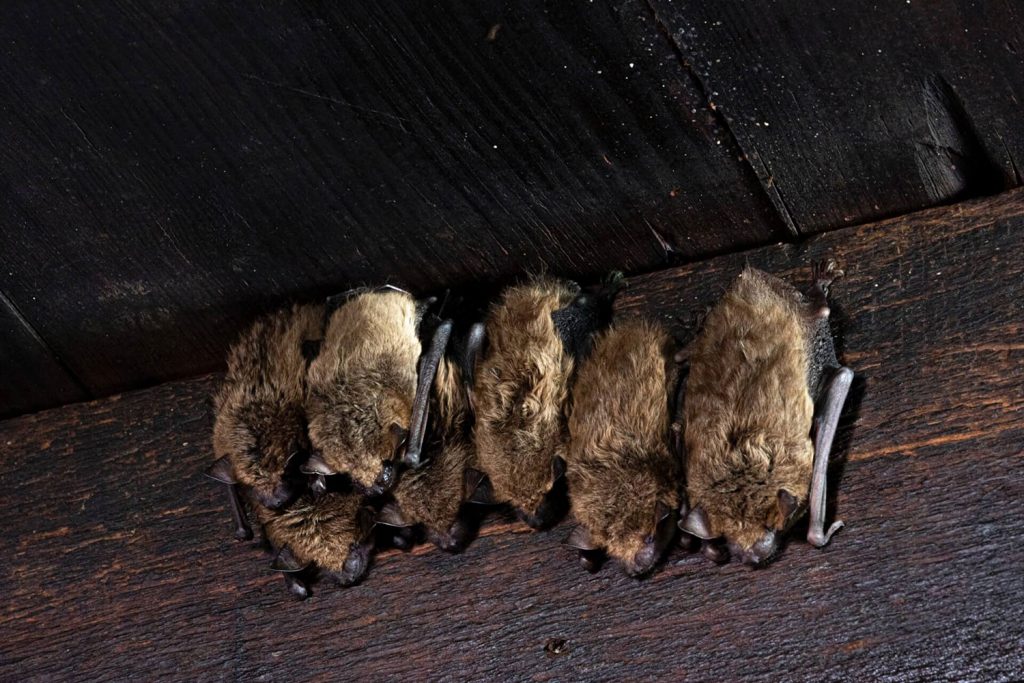Bat Removal in Orlando, FL
Do you need to get rid of bats in Orlando? We can help!
Bat problem in Orlando?
Call for a Free Inspection

Bats in Orlando
Florida is home to thirteen bat species, and all of them eat insects. One bat can consume thousands of flying insects. They provide incredible benefits to the environment and the economy; however, they cause problems when they end up in your house.
Bat infestations fall into one of two categories:
- Roosting maternity colony in the attic or on the roof
- Lone bat in the living area of a house
The most common bat problem is a roosting maternity colony. Bats like the Brazilian Free Tail look for safe, warm places to give birth in March and April. Bat pups are totally reliant on their mothers. It is inhumane to separate the female bats from their young before the pups can fly.
Each situation is unique. We develop a custom bat control solution depending on the type of house, the location of the infestation, the size of the bat colony, and the condition of the property.
Humane Bat Removal in Orlando

Bat Inspection
The most common places to find roosting bats is in attics, under shingles or eaves, and inside wall voids. Our wildlife experts look for current and potential entry points, evidence of bat activity like guano, and if flightless pups are present. During the inspection, we will identify all locations to exclude and the best place to install a bat valve.

Bat Excluders
Installing a one-way bat valve (bat excluder) is only humane bat removal option. The one way valve allows bats to painless leave your house but prevents their return.
It typically takes three to seven days to ensure all bats have evicted themselves.
The best time to install a bat valve is in the fall because the pups are old enough to fly on their own. Bat removal is illegal without a permit between April 15 to August 15 in Orlando.

Bat Exclusion
Bats enter homes through openings and gaps found near windows, doors, roof lines, and chimneys. In order to prevent entry, seal all holes big enough for bats to fly through with screens, caulk, or grates. Some bat species have been known to return to roost locations so it is important to protect your house with exclusions to prevent future bat problems.

Evidence of Bats in the House
Bats are nocturnal so homeowners rarely see the actual bats. The most common signs of a bat infestation are hearing bat sounds or smelling bat droppings.
Bat Sounds
Homeowners can hear bats when they roost in enclosed spaces like an attic. The bat noises in the attics sound like chirping.
Bat Guano
Bat defecate under their roost location. You can find deposits of guano accumulating within walls and attics as well as on the ground and roof tiles. In extreme cases, homeowners report a musty smell with a hint of ammonia.

Dangers of Bat Infestation
Though they are mainly nuisance pests, bats can cause some damage to buildings and can harm your health.
PROBLEMS WITH BAT GUANO
Collections of bat guano (feces) and urine in areas where the animals roost can lead to structural issues and the possible collapse of ceilings caused by the corrosive nature of their waste. Bat droppings are also the catalyst for two fungal diseases — histoplasmosis and cryptococcosis. Both of these are fungal diseases originating from infectious spores in the animals’ droppings. If their fecal matter is disturbed, the chance for disease transmission is great, as airborne spores can be inhaled into homeowners’ lungs.
How Does Trutech Get Rid of Bats in Orlando?
When natural bat habitats overlap with residential areas, conflicts arise. Bats tend to live inside attic spaces of your home; however, we have seen them in other spaces such as behind paneling on the sides of your homes, inside gable vents, chimneys, and various other places.
Because they are so small compared to other wildlife animals they’re able to sneak into small spaces and can enter your home through AC vents.
The experts at Trutech Wildlife Removal get rid of bats by sealing all bat entry points once the bats are gone.
The most common bat entry points include:
- Attic Vents
- Soffits
- Fascia boards
- Gable vents
- Roof Returns or Eaves
- Chimneys
- Siding
Bats in Attic Removal
Attics offer the warmth, humidity, and shelter necessary for rearing young pups.
Bats gain access to attics through gaps in roof shingles, mortar, windows, doors, and home ventilation systems. Gable vents are a common bat entry point into the attic.
Excluder valves or exclusion tubes are a one-way exit, allowing bats in the attic to leave but not to return. The process typically takes three to seven days to ensure all bats are out. After a final attic inspection, we remove the valve and seal the final exit point.
Bats in Wall Removal
After gaining access to an attic, bats can make their way behind walls. These spaces provide darkness and seclusion bats seek out.
It is especially important to call the professionals to get rid of bats inside the wall. A bat inside the walls may become stuck. This is especially common for young bats, which have not yet mastered flying. If left alone, trapped bats often starve and die in wall voids.
Bats in Chimney Removal
Chimneys provide easy access entry points for bats. You can hear bats make high-pitched squeaks in chimneys. If you find bats in the chimney, do not open the flue or try to smoke out the animals. At Trutch, we get rid of bats from chimneys by installing an a one-way exit and sealing the chimney with mesh screens or chimney caps.
Bats in Florida
Bats are found in nearly every geographic region in Florida. Favorite environments include tropical forests, woodlands, open fields, both suburban and urban communities, and even deserts. Roosting requirements usually depend on the species, but caves, trees, hollowed logs, rock crevices, and human dwellings serve as excellent habitats.
In the state of Florida, not only is it illegal to kill or trap bats, but you cannot evict bats from your home if flightless pups are present.
Bat maternity colonies begin to form in early April. These roosts are frequently near areas prone to insect swarms such as fields, ponds, or neighborhoods. In the late spring or summer, homeowners who see bats leaving an attic or overhang at twilight may need to check for an infestation. If you need bat removal in Central Florida between April 15 and August 15, you need a special permit to install bat exclusions.
Call for a Free Inspection
Frequently Asked Questions
Pets are the most likely member of the household to be bitten by a rabid bat, as they are exposed to the risk of infection outdoors and can’t communicate being bitten or feeling ill. However, as one of the primary carriers of rabies in the U.S., bats should be a concern for people as well. When homes are infested, the chances of bat bites on humans are far higher. Sleeping residents can suffer bat bites as can those trying to shoo a trapped bat out of the house. A difficult disease to identify, rabies doesn’t present symptoms for several months. By the time signs like severe fatigue, muscle weakness, and nausea emerge, the deadly disease has often progressed too far to be cured.
Bats are beneficial due to their insect-eating habits, but a quick encounter with them can bring lethal consequences. Immunizations that help prevent rabies are recommended for anyone in an area with high insect activity. Due to the painless nature of bat bites, those who have been near these pests are advised to receive cautionary treatment from a physician. Keep in mind that symptoms typically associated with rabies, such as mouth foaming, aggressiveness, and hydrophobia, are rarely present in humans, so any bite should be treated as a potential threat. When bats are observed in the home, attic, or garage, leave the removal risks to the experts at Trutech.
Unless there is a large number of bats in the attic, infestations can continue for a long time without being noticed by homeowners. Look for the winged animals leaving the attic at dusk and returning sometime during the pre-dawn hours. They can also be detected by noticing stains on exterior walls caused by bat excrement. Inside the house, the smell of guano can become noticeable over time. Large infestations of bats in the attic can deposit enough guano to make the ceiling sag and eventually collapse.
Notoriously nocturnal, bats are also shy creatures that can become expert hiders once in the home. However, bats in the home are largely just accidental occurrences. A single bat can fly into a home without realizing it (despite many incursions pointing to maternal roosting). Homeowners should utilize a variety of methods to verify bat infestations. For one, bats emit high-pitched squeaks and scratching sounds commonly heard in the evening. Bat droppings also tend to accumulate under where the animals roost. Similar in appearance to rodent droppings, bat feces has a pungent odor and appears shiny due to the animals’ diet of insects.
Bats leave plenty of evidence for property owners. For one, seeing the animal flying around treetops and into trees directly tends to be the most common sign. Such behavior occurs in the evening, which makes sighting bats difficult. In such cases, finding bat droppings at the base of a tree is a sure way to know that at least one of the animals is roosting on your property. Noticing missing or damaged bark can also be a sign that bats in trees are present.
Positively identifying what kind of animal is living within the walls is important to begin removal. Bats make high-pitched squeaks, which are employed to find insects and heard mostly during the night. Various scratching and other movements may be heard from walls, as well. If droppings are present, residents should look for dark, greasy scat with visible insect body parts. As finding bat guano within walls can prove difficult, it is wise to check other popular bat hangouts like house eaves and attics.
The only way to permanently keep bats away is with a full exclusion done to the home. This will consist of screening gable end vents, sealing behind fascia board along eaves, sealing construction gaps, sealing dormer corners, sealing ridge caps, and any other areas that will allow a bat to enter into the home. If bats are currently present, a bat valve will be installed which is a one-way door that allows the bats to easily leave the home but does not allow them to get back in. Once all bats have left through the bat valve, it may then be removed and permanently sealed. As for sound machines and repellents, no. Although it may seem that it rustles the bats at first, it is simply the activity of your presence. The bats will soon settle down and continue to roost in that area. If there is a food source present in an area, bats will stay put.
This is something we deal with on a regular basis. If you have this significant of guano buildup, we suggest letting us inspect your property for any other potential entry points. When the bats are evicted from the vent, they will naturally look for another way into their — or in this case, your — home. Also. while you may not see bats in the attic or home, you are not necessarily in the clear. The urine and guano of bats are very corrosive and can deteriorate the bottom of gable vents. Eventually the vent will rot and bats will inhabit the space between the walls and brick, siding, or rock. Don’t procrastinate, as guano can build up fast inside these voids. This not only causes the health risks you hear about but can attract other bats for years to come.


